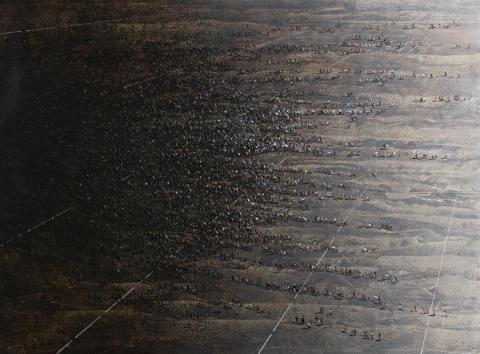RUNNING FIGURES, 1975
LAWRENCE DAWS
oil on canvas
183.0 x 244.0 cm
signed lower left: DAWS
Sophie Gannon Gallery, Melbourne
The K.D.H. Ainsworth Collection, Queensland
Lawrence Daws, Sophie Gannon Gallery, Melbourne, 1 May - 2 June 2007 (illus. in exhibition catalogue)
One of the country's most subtle yet forceful painters, Lawrence Daws has enjoyed a long and successful career immortalising various aspects of the Australian landscape with images that continue to tantalise, challenge and intrigue long after their initial encounter. From the parched earth and olive trees of his childhood on the Fleurieu Peninsula, South Australia, through the Tanami and remote deserts of the Northern Territory to the tropical rainforests and strange volcanic formations of Queensland where he has resided since 1970, Daws imbues his work with a disquieting melange of foreboding and dreamlike tranquillity. Yet irrespective of the physical geography of his work, always present is 'the inner landscape of the unconscious mind ... an uneasy terrain of fears, dreams and desires, where mysterious land forms combine with tiny running figures, monstrous pythons, gigantic birds and faceless female nudes, whose nakedness threatens as much as it seduces. Betraying a myriad of influences ranging from Freud, Jung, the Tarot and Alchemy to Casper David Friedrich and Piero della Francesca, his paintings contain symbols of both the collective unconscious, 'the whole spiritual heritage of mankind's evolution', as well as that of the individual psyche. They are places of exquisite beauty seen through a thin blue veil - a state half-way between waking and nightmare - that also contain an almost unbearable tension in which we sense that something terrible is about to happen but cannot explain why.'1
Featuring crowds of tiny figures running lemming-like towards disaster, the present composition is unmistakably related to the artist's earlier 'Omen series' which, executed between September 1972 and March 1973, is characterised by disturbing references to cages, burning spheres, speeding trains on fire, and crowds which race purposefully towards open cage doors. Among Jung's celebrated motifs, the cage notably symbolises both ensnarement and sanctuary - each of which importantly offer the possibility of transformation. While here the cage has disappeared, Daws still captures the residual panic of people fleeing from the lighter area to the darkness, with tribes or groups forming as they approach the impending doom - a powerful statement upon man's inability to handle freedom. Emphasising the terror implicit in such visions, James Gleeson elucidates:
'... in short, Daws' imagery is fearful and apocalyptic. He is saying that every action is a step towards disaster and, through some instinct for self-destruction man is compelled to frenetic action. We willingly rush towards catastrophe. Much of his painting is about action, but there is always the implication that the action springs from panic, from a situation out of control, or because it has been whipped on by malevolent, or indifferent, forces of destiny ... He sees man as a born cage-dweller, as a species marked out and perversely working towards its own extinction. It is a decidedly pessimistic view and most of his revelations occur at night or at dusk, at the end of the long day's journey, yet it is undeniably a powerful and impressive image of the human situation ...'2
Although viewed in isolation, works such as Running Figures, 1975 certainly seem a pessimistic critique of the human condition, when considered within the context of Daws's complex and continually evolving oeuvre comprised of many contrasting, interwoven strands, they may be understood, rather, as another step on the artist's journey towards regeneration - inextricably linked to positive themes of fulfilment, redemption and rebirth. Indeed, as art critic Sue Smith observes, for Daws '... this experience of anxiety and threat is not negative. He believes it is necessary to live through anxious or dangerous situations to arrive at a state of peace - the process of suffering and insight being necessary in his view for the forging of a whole personality.'3
1. Bruce, C., 'Foreword', Lawrence Daws, Sophie Gannon Gallery, Melbourne, exhibition catalogue, 2007, unpaginated
2. Gleeson, J., 'Paintings that need to be read', Sun Herald, Sydney, 15 July 1973
3. Smith, S., 'Landscape of the psyche', The Courier-Mail, Brisbane, 3 August 1996
VERONICA ANGELATOS
